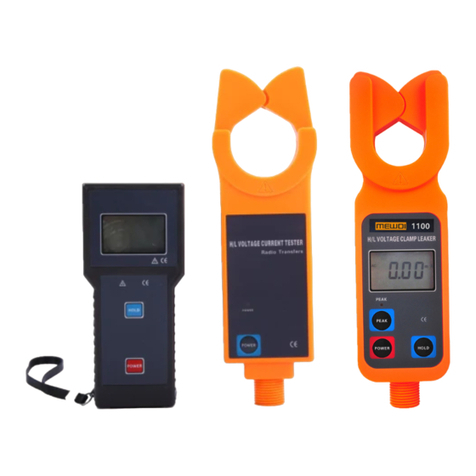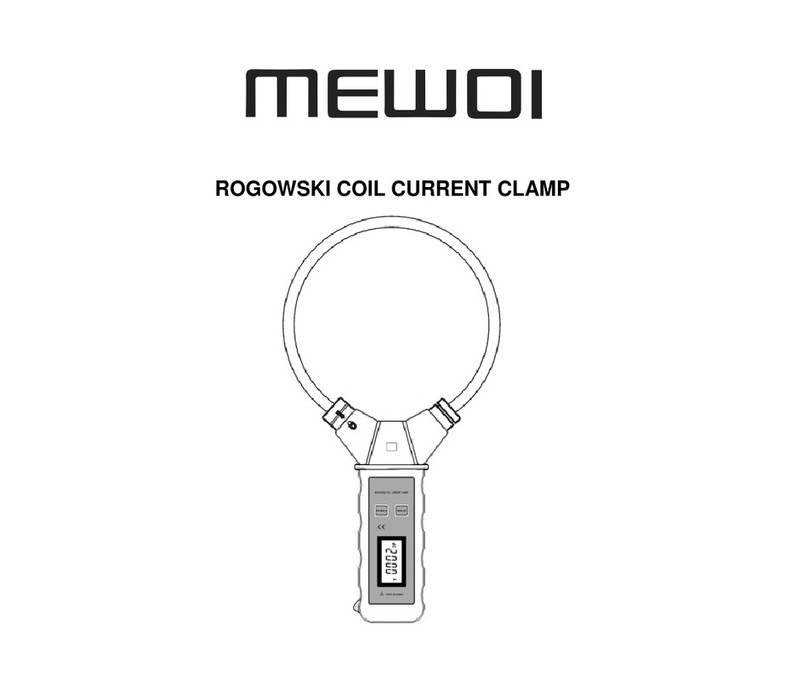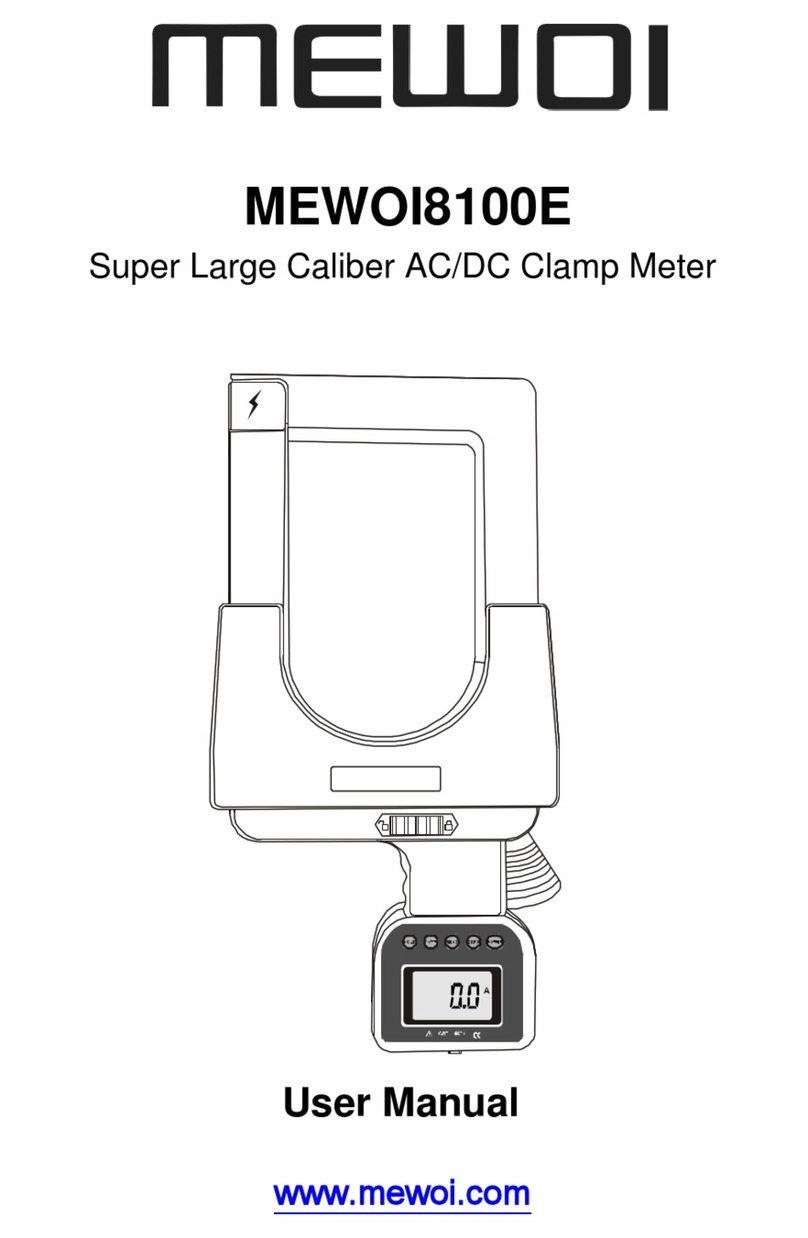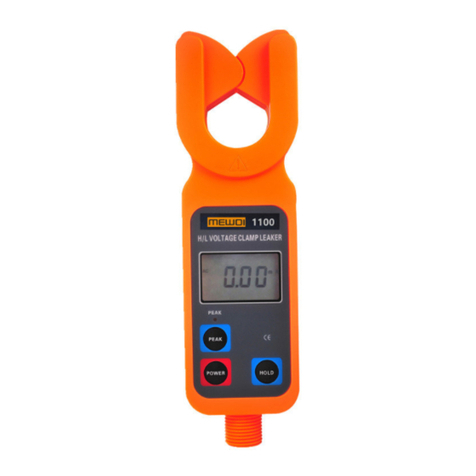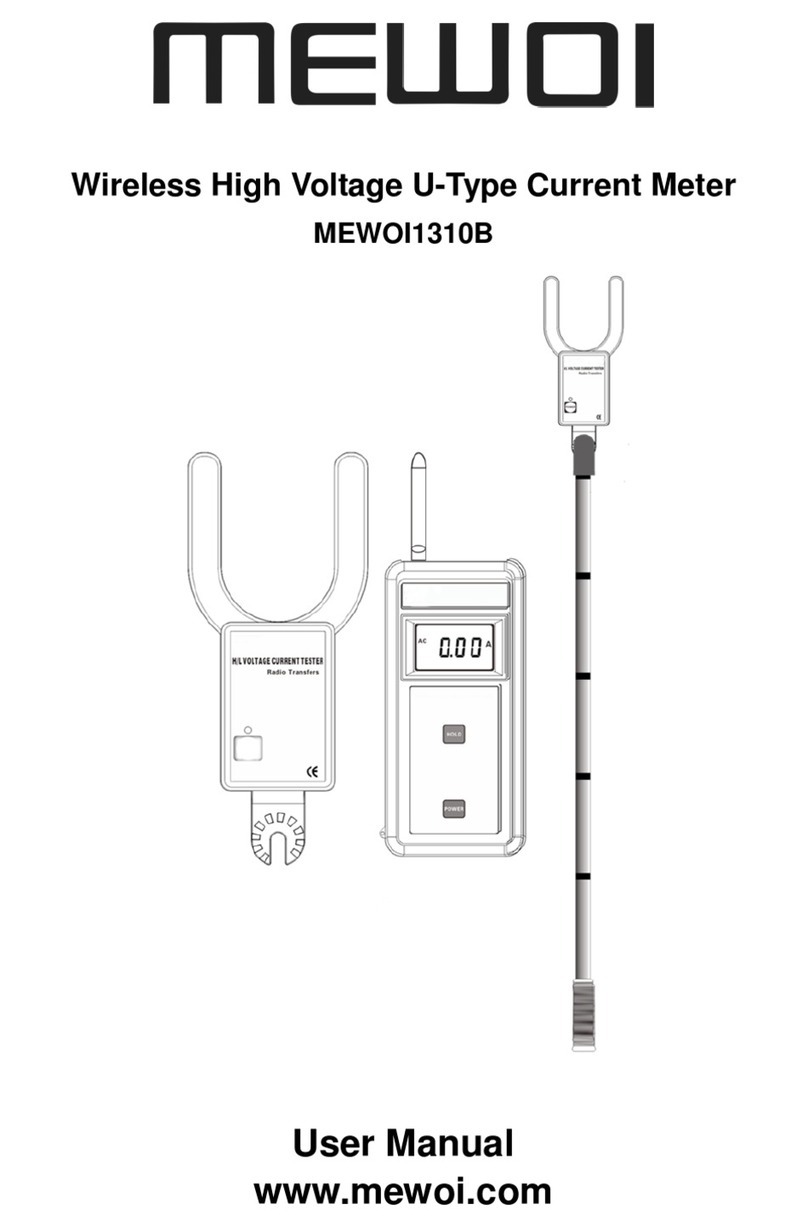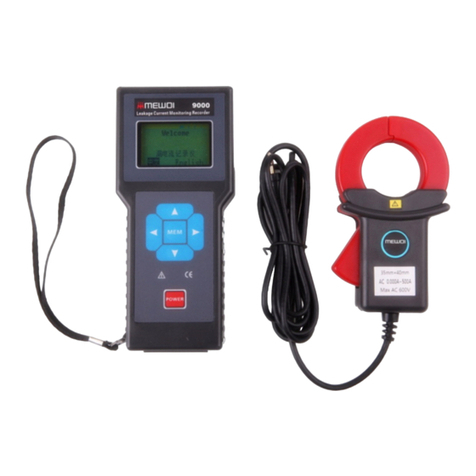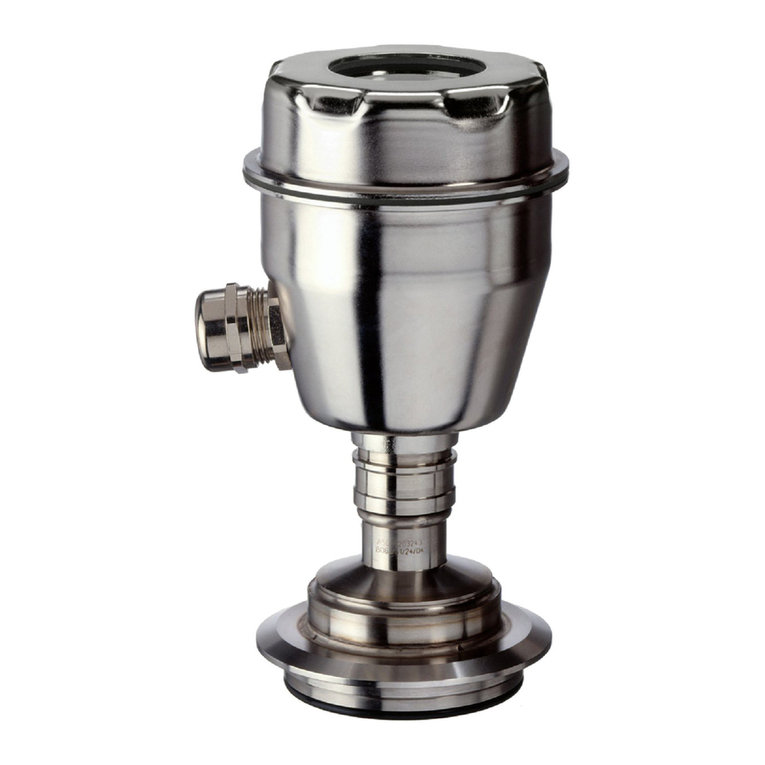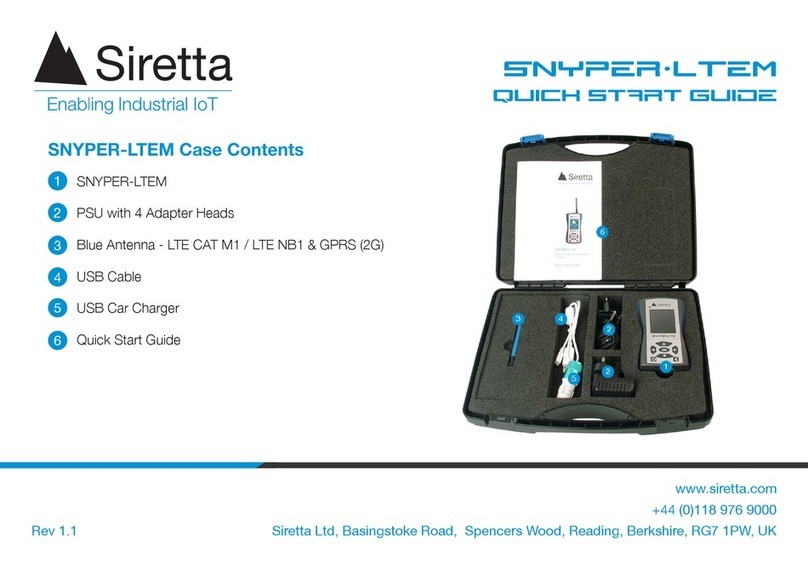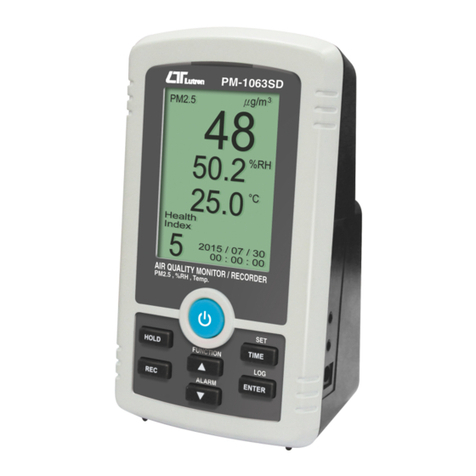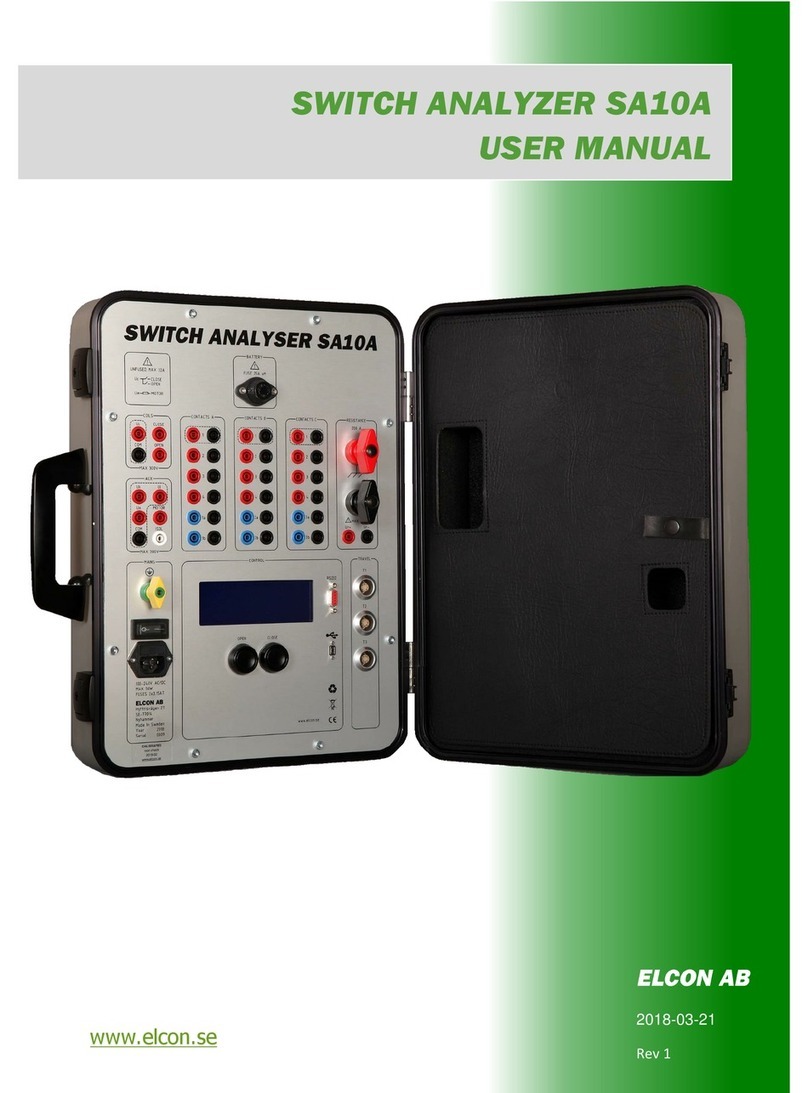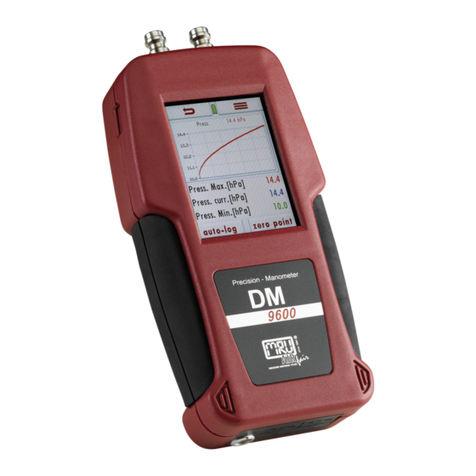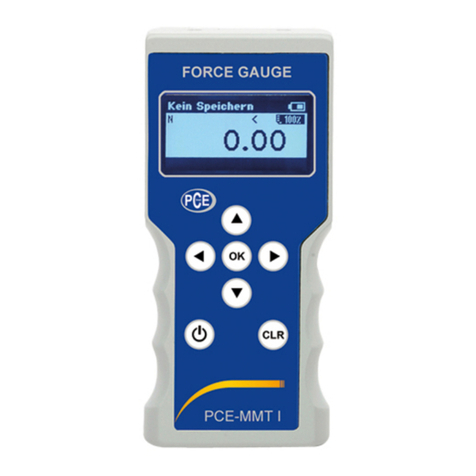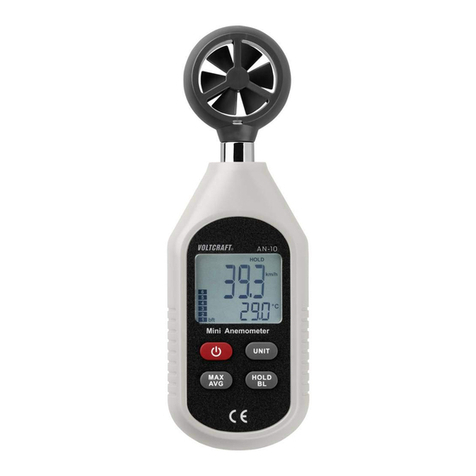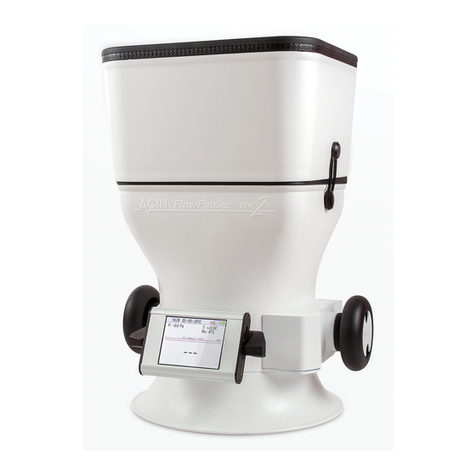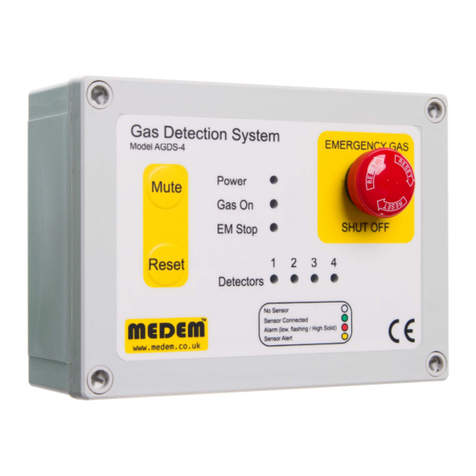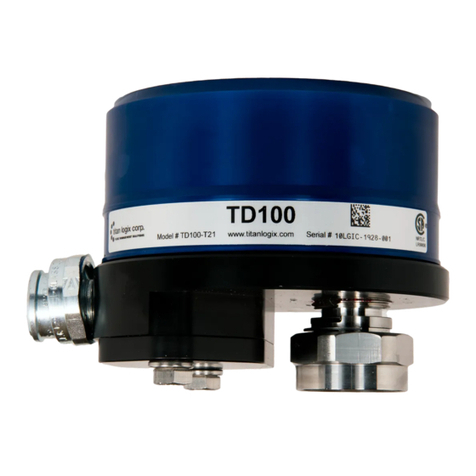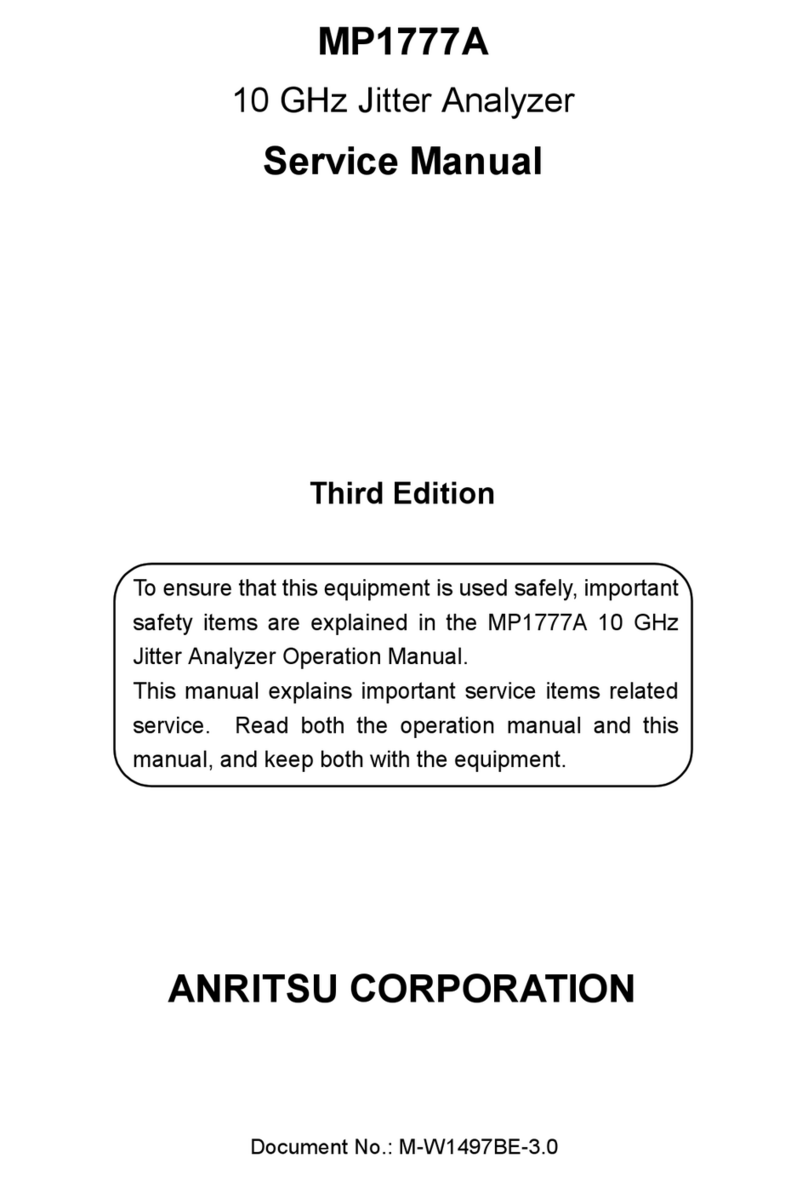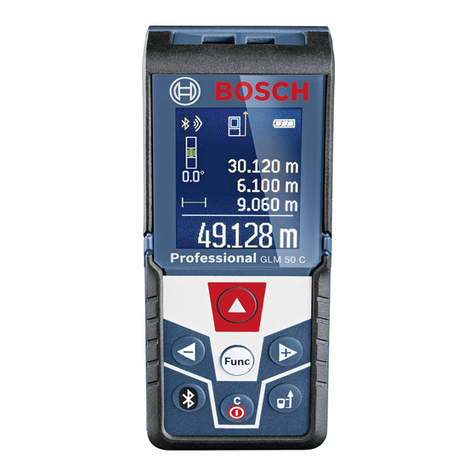MEWOI MEWOI-HY128 Series User manual

Sound Level Meter
MEWOI-HY128 Series
User Manual
www.mewoi.com


CONTENT
I. Brief Introduction....................................................................... 1
II. Specifications and technical parameters.................................16
III. Main structure and working principle ...................................... 21
IV. Use and operation................................................................... 22
V. Fault analysis and elimination................................................. 68
VI. Complete set of products........................................................ 71
VII. Maintenance of the instrument................................................ 74

I. Brief Introduction
1.1 Main purpose and scope of application
HY128 series sound level meter is a digital multi-function sound
level meter, designed to measure the frequency weighted and time
weighted sound pressure level, equivalent continuous sound level,
exposure sound level, statistical sound level, etc. of various types
of noise Acoustic evaluation, it has 7 working modes of integral
average, parallel measurement, statistical analysis, 24h
measurement, 1/1 octave, 1/3 octave and indoor noise for users to
choose. At the same time, the instrument also provides low
frequency A frequency Weighting, used for secondary radiation
noise measurement.
HY128 series sound level meters comply with the national
standard GB/T 3785.1-2010 and the international standard IEC
61672-1:2013 "Sound Level Meter", GB/T15952-2010 and
IEC61252:2002 "Personal Sound Exposure Meter Specification",
GB/T 3241 -2010 and IEC 61260:2014 "Octave and Fractional
Octave Filter" requirements. Structure-borne noise (indoor noise)
meets the requirements of "GB 22337-2008 Environmental Noise
Emission Standard for Social Life" and GB 12348-2008
"Environmental Noise Emission Standard for Industrial Enterprises
and Plant Boundaries", and the secondary radiation noise meets
the requirements of "JGJ/T 170-2009" Building vibration and
secondary radiation noise caused by urban rail transit and its

measurement method requirements, 24h noise monitoring meets
the requirements of GB 3096-2008 "Sound Environmental Quality
Standard" and HJ 640-2012 "Environmental Noise Monitoring
Technical Specifications for CitiesAccording to the requirements of
"Conventional Monitoring of Acoustic Environment", the coding of
environmental monitoring points meets the requirements of HJ
661-2013 "Environmental Noise Monitoring Point Coding Rules".
HY128 series sound level meter is a hand-held instrument with
powerful functions and excellent performance. It is suitable for
long-term, reliable and accurate measurement of various types of
noise. It has an 8G (maximum 32G optional) SD card, and comes
with standard 5AA batteries. For instruments which has 24h
measurement function, the company also provides a dedicated
power bank for power supply. At the same time, users can also
choose recording, timing shutdown, GPS positioning, Bluetooth
and other functions according to their needs. It is suitable for
on-site measurement of mechanical and electrical product noise,
environmental noise, traffic noise, industrial hygiene, and
workplace noise.
HY128 series sound level scoring is divided into explosion-proof
type and non-explosion-proof type. The explosion-proof products
have obtained the explosion-proof certificate, and the
explosion-proof marks are Ex ib I Mb and Ex ib IIb T4 Gb.
Explosion-proof products have double protection and can be used
in special environments that meet the explosion-proof signs.

Warning!!!
1. Before using the explosion-proof product, read the product
manual in detail.
2. Explosion-proof products cannot be arbitrarily connected
with other equipment that has not been inspected. Power
banks can only be used in non-explosion-proof environments.
3. Check carefully before use, and stop using it immediately if
any abnormality is found during use.
4. Explosion-proof products can only use LR6 alkaline zinc
manganese dry batteries.
5. If the explosion-proof product fails, it can only be sent back
to the company for repair.
1.2 Configurations
HY128 is a high-precision, powerful noise measuring instrument.
In order to meet the requirements of different users, HY128 has a
variety of different models and configurations, which are
distinguished by the label on the back of the instrument. The
various configurations of HY128 are shown in Table 1.
Model
No.&Configuration
Type
Integral
average
Statistics
analytical
24h
Test
Integral
parallel
Indoor
Noise
1/1
OCT
1/3
OCT
HY128
(Basic)
Class
1
√
√
√
HY128
Configuration1
Class
1
√
√
√
√
√
HY128
Class
√
√
√
√
√
√

Configuration 2
1
HY128
Configuration 3
Class
1
√
√
√
√
√
√
√
HY128A
Class
1
√
√
HY128
(Basic)
Class
2
√
√
√
HY128B
Configuration 1
Class
2
√
√
√
√
√
√
HY128C
Class
2
√
√
Table 1 Configuration of HY128 series instruments
1.3 Working environment conditions
The working environment conditions of HY128 series sound level
meters are as follows:
•Air temperature:
——-10℃~+50℃for class 1 instruments, note: -10℃~+40℃for
explosion-proof instruments;
—— 0℃~+40℃for class 2 instruments;
•Relative humidity: 20%~90%;
•Static pressure: 65 kPa~108 kPa.
LCpeak hold for the duration of the measurement.

1.4 Measurement function
1.4.1 Introduction
HY128 series sound level meters all have the functions of ordinary
sound level meters. See Table 1 for the specific models and
configurations of the functions. HY128 series sound level meters
have integration time settings (time is 1s~99h59min59s, when the
time is set to 0, the default is manual, as the time is set to
99h59min59s), automatic repeat measurement (time number is
1~99, When set to 1 time, it is actually a onetime measurement)
function, and also has the setting of repeated start measurement
time interval (interval is 0s~99h59m59s, only the number of
repeated measurements is set to 2 times or more). The instrument
has three starting modes: manual, timing and threshold. When the
measurement time is set, the measurement is automatically
started in synchronization with the instrument clock. When the
threshold sound level is set (the instrument must be started first
and wait for measurement after setting the threshold), When the
measured sound level exceeds the threshold, the measurement is
automatically started.
1.4.2 Ordinary sound level meter
The main interface of the HY128 series sound level meter can be
used as an ordinary sound level meter, the main measurement:
•Measure A frequency weighted F time weighted sound level;
•Measure Afrequency weighted F time weighted maximum sound
level;

•Measure A frequency weighted F time weighted minimum sound
level.
1.4.3 Integral Average
The measurement mode of HY128 series sound level meter has
integral average. In this mode, the frequency weighting has A, C
and Z weighting, and the time weighting has F, S and I weighting. It
provides the operator to choose the appropriate frequency and
time weighting. Measurement, main measurement:
•Time average sound level (equivalent continuous sound level);
•1 s short-term time average sound level (short-term equivalent
continuous sound level);
•Time-weighted sound level;
•C-frequency weighted peak sound level;
•The maximum time-weighted sound level;
•The minimum time-weighted sound level;
•Normalized 8 h average sound level;
•Sound exposure level;
•Acoustic exposure;
•Noise dose (reference sound level is 90 dB, reference duration
is 8 h, exchange rate is 3 dB);
•Measurement duration;
•Measure elapsed time.
1.4.4 Statistical Analysis
The measurement mode of HY128 series sound level meter has
statistical analysis. In this mode, frequency weighting is only A

weighting, and time weighting is only F weighting. The main
measurement:
•A frequency weighted time average sound level (equivalent
continuous sound level);
•1s short-term A frequency weighted time average sound level
(short-term equivalent continuous sound level);
•A frequency weighted F time weighted sound level;
•A frequency weighted F time weighted maximum sound level;
•The minimum value of A frequency weighted F time weighted
sound level;
•A frequency weighted sound exposure level;
•Cumulative percentage sound level (statistical sound level) LN
(the default percentage N is 5, 10, 50, 90 and 95, the user can also
change it in the settings, N=1~99);
•Standard deviation;
•Measurement duration;
•Measure elapsed time.
1.4.5 Parallel measurement
The measurement mode of HY128 series sound level meter has
parallel measurement. In this mode, the frequency weighting has A,
C and Z weighting, and the time weighting has F, S and I weighting.
The frequency and time weighted sound level are measured in
parallel. , The main measurement:
•Weighted sound level (Lp) at each time;
•The maximum value of the weighted sound level (Lmax) at each

time;
•The minimum value of the weighted sound level at each time
(Lmin);
•Average sound level at each time (LeqT, equivalent continuous
sound level);
•Weighted peak sound level of each frequency (Lpeak);
•Sound exposure level (LE);
•Measurement duration;
•Measure elapsed time.
1.4.6 24h Measurement
The measurement mode of HY128 series sound level meter has
24h measurement (HY128A and HY128C do not have this
function). In this mode, frequency weighting is only A weighting,
and time weighting is only F weighting. The main measurement:
•Day/night/night equivalent sound level Lden;
•Daytime equivalent sound level Ld;
•Evening equivalent sound level Le;
•Night equivalent sound level Ln;
•24 h and hourly:
——A frequency weighted time average sound level (equivalent
continuous sound level);
——1 s short-term A frequency weighted time average sound level
(short-term equivalent continuous sound level);
——Afrequency weighted F time weighted sound level;
——Afrequency weighted F time weighted maximum sound level;

——Afrequency weighted F time weighted minimum sound level;
——Afrequency weighted sound exposure level;
——Statistical sound level LN (the percentage N is 5, 10, 50, 90
and 95);
-Standard deviation SD.
1.4.7 Indoor noise
The measurement modes of HY128 (configuration 1),
(configuration 2), (configuration 3) sound level meters and HY128B
(configuration 1) sound level meters include indoor noise
measurement. In this mode, the frequency weighting is only A
weighting, and the time Weighting is only F weighting, and the
main measurement:
•31.5Hz frequency band sound pressure level value (without
weighting), maximum and minimum values;
•63Hz frequency band sound pressure level value (without
weighting), maximum value, minimum value;
•125Hz band sound pressure level value (without weighting),
maximum and minimum values;
•250Hz frequency band sound pressure level value (without
weighting), maximum value, minimum value;
•500Hz frequency band sound pressure level value (without
weighting), maximum value, minimum value;
•A frequency weighting equivalent continuous sound level,
maximum and minimum.
For the measurement result exceeding the limit, it is marked with *.

1.4.8 1/1 octave
The measurement modes of HY128 (configuration 2),
(configuration 3) sound level meters and HY128B (configuration 1)
sound level meters have 1/1 octave measurement, including 11 1/1
octave filter center frequencies: 16 Hz, 31.5 Hz, 63 Hz, 125 Hz,
250 Hz, 500 Hz, 1 kHz, 2 kHz, 4 kHz, 8 kHz and 16 kHz. In this
mode, the frequency weighting has A, C and Z weighting, and the
time weighting has F and S weighting. It provides the operator to
select the appropriate frequency and time weighting measurement.
The main measurement is:
•Time average sound level in each frequency band (LeqT,
equivalent continuous sound level);
•The maximum weighted sound level (Lmax) of each frequency
band;
•The minimum weighted sound level of each frequency band
(Lmin);
•A-weighted time average sound level, maximum and minimum;
•C-weighted time average sound level, maximum and minimum;
•Z-weighted time average sound level, maximum and minimum.
1.4.9 1/3 octave
The measurement mode of the HY128 (configuration 3) sound
level meter has 1/3 octave measurement, including 32 1/3 octave
filter center frequencies: 16 Hz, 20 Hz, 25 Hz, 31.5 Hz, 40 Hz, 50
Hz, 63 Hz, 80 Hz, 100 Hz, 125 Hz, 160 Hz, 200 Hz, 250 Hz, 315
Hz, 400 Hz, 500 Hz, 630 Hz, 800 Hz, 1 kHz, 1.25 kHz, 1.6 kHz, 2

kHz, 2.5 kHz, 3.15 kHz, 4 kHz, 5 kHz, 6.3 kHz, 8 kHz, 10 kHz, 12.5
kHz, 16kHz and 20kHz. In this mode, the frequency weighting has
A, C and Z weighting, and the time weighting has F and S
weighting. It provides the operator to select the appropriate
frequency and time weighting measurement. The main
measurement is:
•Time average sound level in each frequency band (LeqT,
equivalent continuous sound level);
•The maximum weighted sound level (Lmax) of each frequency
band;
•The minimum weighted sound level of each frequency band
(Lmin);
•A-weighted time average sound level, maximum and minimum;
•C-weighted time average sound level, maximum and minimum;
•Z-weighted time average sound level, maximum and minimum.
1.5 Symbols and definitions
See Table 2 for the meanings of terms, symbols and
abbreviations that may be used in this manual.
Table 2 List of terms and symbols
Nouns and symbols
Definition or description
Overload sign
Under-limit flag
▲
Page up
▼
Page Down
Page left

Page Right
External power supply sign
Measurement result interface under-range mark
Threshold start flag
Timing start flag
Code
Environmental monitoring point
(dB)
Sound level measurement unit
EA
A frequency weighted acoustic exposure
EC
C-frequency weighted acoustic exposure
EZ
Z-frequency weighted acoustic exposure
F time weighting
A standard time weighting used for sound level meters
FreqWt
Frequency weighting
INT
Integral average measurement result format
I pulse time weighting
A standard time weighting used for sound level meters
L5
Calculated by statistical analysis, 5% of the sound
pressure level exceeds this sound pressure level.
L90
Calculated by statistical analysis, 90% of the sound
pressure level exceeds this sound pressure level。
LAE
A frequency weighted sound exposure level
LAeqT
Equivalent continuous sound pressure level, a measure of
the average value of the A-weighted sound pressure level
over time during the measurement period, in dB.
LAeq1s
1s equivalent continuous sound pressure level, a measure
of the average value of the A-weighted sound pressure
level over time during the measurement period, in dB.

LAF
A frequency weighted and F time weighted sound level
LAFmax
A frequency weighted and F time weighted maximum
sound level
LAFmin
A frequency weighted and F time weighted minimum
sound level
LAI
A frequency weighting and pulse time weighting sound
level
LAImax
A maximum sound level weighted by frequency and pulse
time
LAImin
A minimum sound level for frequency weighting and
pulse time weighting
LAS
A frequency weighted and S time weighted sound level
LASmax
A frequency weighting and S time weighting maximum
sound level
LASmin
A frequency weighting and S time weighting minimum
sound level
LAT1S
A-weighted 1s equivalent continuous sound pressure level
LCE
C frequency weighted sound exposure level
LCeqT
Equivalent continuous sound pressure level, a measure of
the average value of C-weighted sound pressure level over
time during the measurement period, in decibels
LCeq1s
1s equivalent continuous sound pressure level, the
measurement of the average value of C-weighted sound
pressure level over time during the measurement period, in
dB.
LCF
C frequency weighting and F time weighting sound level

LCFmax
C frequency weighting and F time weighting maximum
sound level
LCI
C frequency weighting and pulse time weighting sound
level
LCImax
C frequency weighting and pulse time weighting
maximum sound level
LCpeak
C frequency weighted peak sound pressure level
LCS
C frequency weighting and S time weighting sound level
LCSmax
C frequency weighting and S time weighting maximum
sound level
Ld
Daytime equivalent sound level
Ldn
Day and night equivalent sound level
Lden
Equivalent sound level day and night
LeqT
Equivalent continuous sound pressure level, a measure of
the average sound pressure level over time during the
measurement period, in dB.
Le
Evening equivalent sound level
LE
Sound exposure level
Ln
Night equivalent sound level
LN
Statistical analysis of noise level, N represents the
percentage of excess
LZE
Z frequency weighted sound exposure level
LZeqT
Equivalent continuous sound pressure level, a measure of
the average value of Z-weighted sound pressure level over
time during measurement, in dB.
LZeq1s
1s equivalent continuous sound pressure level, a measure

of the average value of Z-weighted sound pressure level
over time during the measurement period, in dBs.
LZF
Z frequency weighting and F time weighting sound level
LZFmax
Maximum sound level with Z frequency weighting and F
time weighting
LZFmin
Z frequency weighting and F time weighting minimum
sound level
LZI
Z frequency weighting and pulse time weighting sound
level
LZImax
Z frequency weighted and pulse time weighted maximum
sound level
LZImin
Z frequency weighted and pulse time weighted minimum
sound level
LZS
Z frequency weighted and S time weighted sound level
NDA
A frequency-weighted noise dose
NDC
C frequency-weighted noise dose
NDZ
Z frequency-weighted noise dose
Rep
Repeated Measurement
Sync
Synchronous measurement (24h measurement)
SD
Standard deviation
STA
Statistical analysis measurement result format
TimeWt
Time weighting
Tm
Actual measurement elapsed time
Total
Summary
Ts
Measurement start date and time

II. Specifications and technical parameters
a) Performance level
Level 1 or Level 2 specified in GB/T 3785.1-2010/IEC
61672-1:2013.
b) Electromagnetic field
radiation and immunity
classification
Category X specified in GB/T 3785.1 -2010/IEC
61672-1:2013.
c) Frequency weighting
A weighting;C weighting; Z weighting;Low (low
frequency).Note:When A weighting is selected, and
Low ( √) weighting is selected, low-frequency
A-frequency weighting can be realized for secondary
radiation noise measurement. Normally measurement
does not require low-frequency weighting. Keep
"Weighting" in the settings Low (×) weighting.
d) Time weighting
F (fast response);S (slow response);
I (impulse response).
e) Frequency range
10 Hz~20 kHz (level 1); 20 Hz~12.5 kHz (level 2)
f) Nominal working
mode
The nominal working mode is without wind shield and
dust cover, and the microphone is directly installed on
the sound level meter.
g) Reference
environmental conditions
The sound level meter meets the technical requirements
under the following environmental conditions:
Air temperature: 23 ℃;
Relative humidity: 50%;
Static pressure: 101.325 kPa;
There is no strong mechanical vibration, shock, strong
electromagnetic field and corrosive gas around
h) Microphone type
HY205 pre-polarized (back-electret) capacitive type 2
engineering measurement microphone or HY207 type
pre-polarized (back-electret) capacitive type 1
engineering measurement microphone, free-field
frequency response, nominal diameter 12.7 mm, the
nominal sound pressure sensitivity is 50 mV/Pa (the
nominal sound pressure sensitivity level is -26 dB, the
reference is 1 V), and the microphone tip capacitance is
about 15 pF.
The reference point of the microphone is the geometric
center of the diaphragm.
The typical frequency response of HY205/HY207
measurement microphone is shown in Figure 1.
i) Display
128×128 dot matrix liquid crystal display (LCD), 2.2
inches, resolution of 0.1 dB, and data update time of 1 s.
It has warning signs such as overload, under-limit, and

low battery voltage.
j) Measuring range at 1
kHz frequency
30 dB (A)~130 dB (A); 40 dB (C)~130 dB (C);
45 dB (Z)~130 dB (Z
Note: (1) The measurement range on other frequencies
is the sum of the upper and lower limits of the
measurement range of the instrument and the nominal
value of the frequency weighting specified in the
national standard GB/T 3785.1-2010, but the upper limit
does not exceed the measurement range on the 1 kHz
frequency The upper limit and the lower limit are not
lower than the lower limit of the measurement range at a
frequency of 1 kHz.
(2) The measurement range can provide other
non-nominal measurement ranges according to the
needs of users.).
k) Frequency band
(nominal frequency)
1) 11 1/1 octave bands:
16 Hz, 31 Hz, 63 Hz, 125 Hz, 250 Hz, 500 Hz, 1 kHz, 2
kHz, 4 kHz, 8 kHz and 16 kHz;
2) 32 1/3 octave bands:
16 Hz, 20 Hz, 25 Hz, 31 Hz, 40 Hz, 50 Hz, 63 Hz, 80
Hz, 100 Hz, 125 Hz, 160 Hz, 200 Hz, 250 Hz, 315 Hz,
400 Hz, 500 Hz, 630 Hz , 800 Hz, 1 kHz, 1.25 kHz, 1.6
Hz, 2 kHz, 2.5 kHz, 3.15 kHz, 4 kHz, 5 kHz, 6.3 kHz, 8
kHz, 10 kHz, 12.5 kHz, 16 kHz and 20 kHz.
L) Memory
1) 8G memory (up to 32G can be selected).
2) The calibration record is automatically stored in the
memory of the instrument;
3) The measurement record is also automatically stored
in the memory of the instrument.
4) Select USB in "Settings", it can be used as U disk.
m) Directivity
The directivity of HY128 series sound level meters at 1
kHz, 2 kHz, 4 kHz and 8 kHz is shown in Figure 2.
n) Power supply
Power supply
1) Adopt 2 high-power R6P batteries or LR6 alkaline
batteries for power supply.
2) When the battery voltage is lower than 1.9V, the
battery symbol on the display becomes empty and starts
to flicker.
3) It can be connected to the USB port (voltage range 3
V~5.2 V) for external power supply.
4)When the working mode is 24h measurement, it is
recommended that the user use the company's dedicated
power bank for power supply.
This manual suits for next models
3
Table of contents
Other MEWOI Measuring Instrument manuals

MEWOI
MEWOI MEWOI1200 User manual
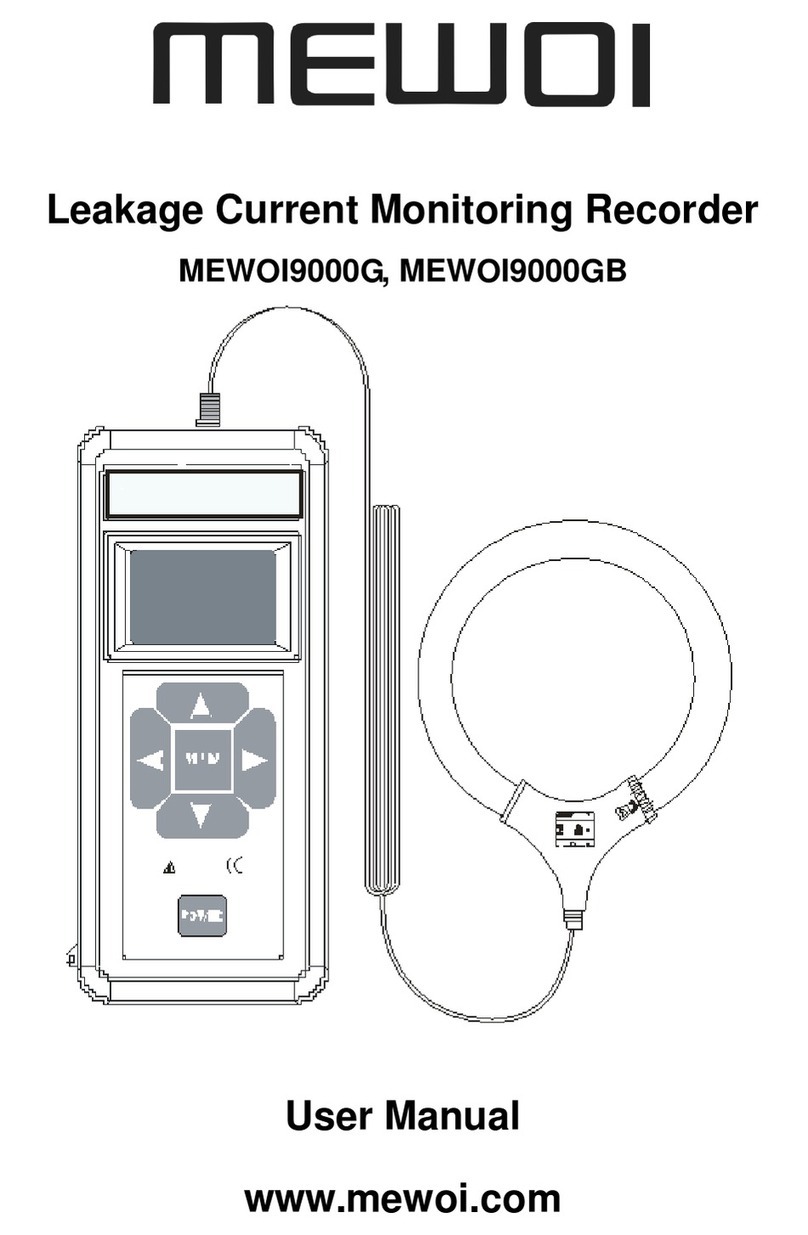
MEWOI
MEWOI MEWOI9000G User manual
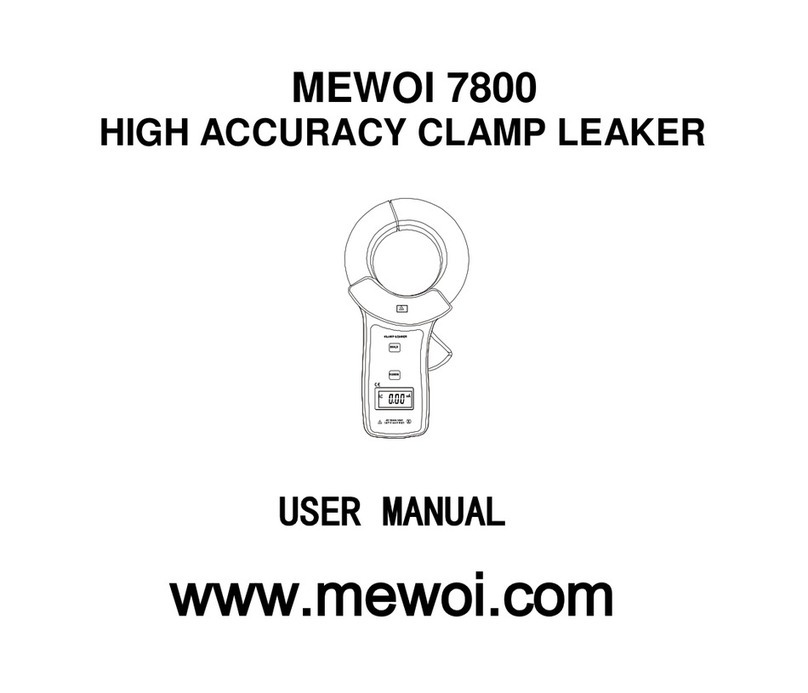
MEWOI
MEWOI 7800 User manual
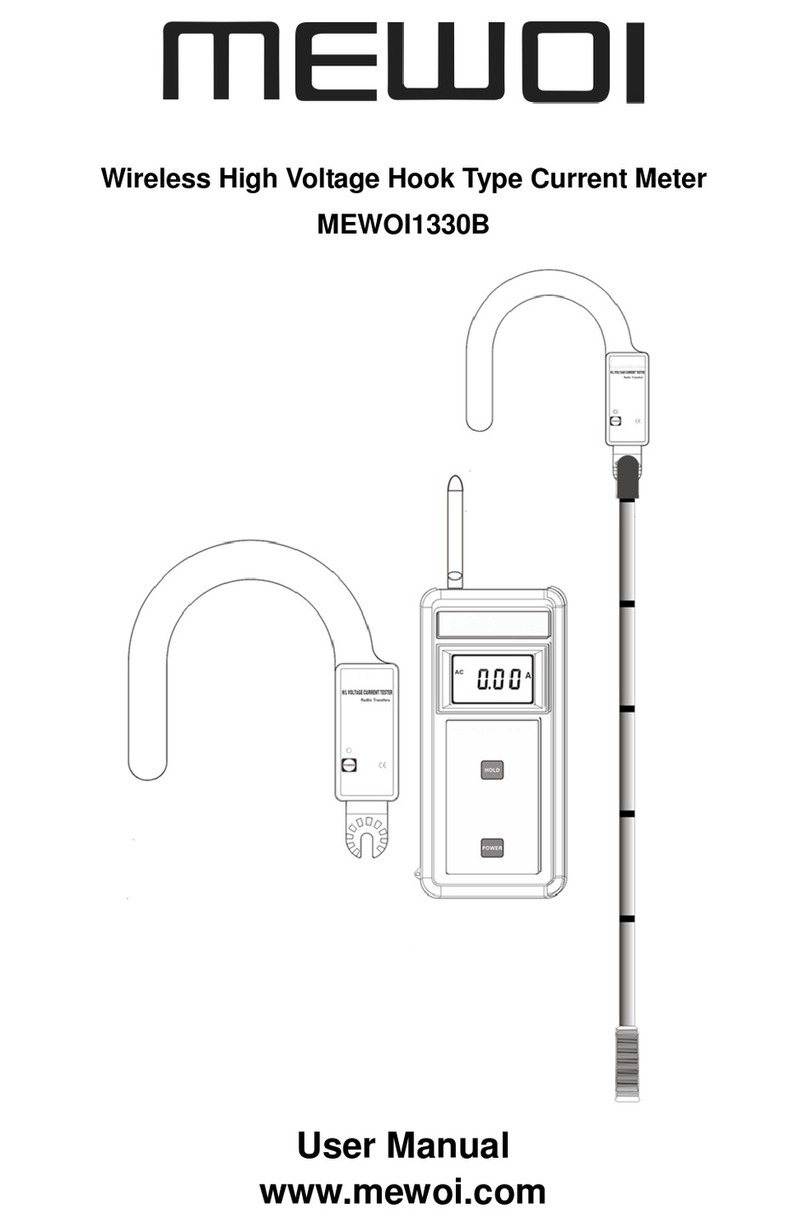
MEWOI
MEWOI MEWOI1330B User manual
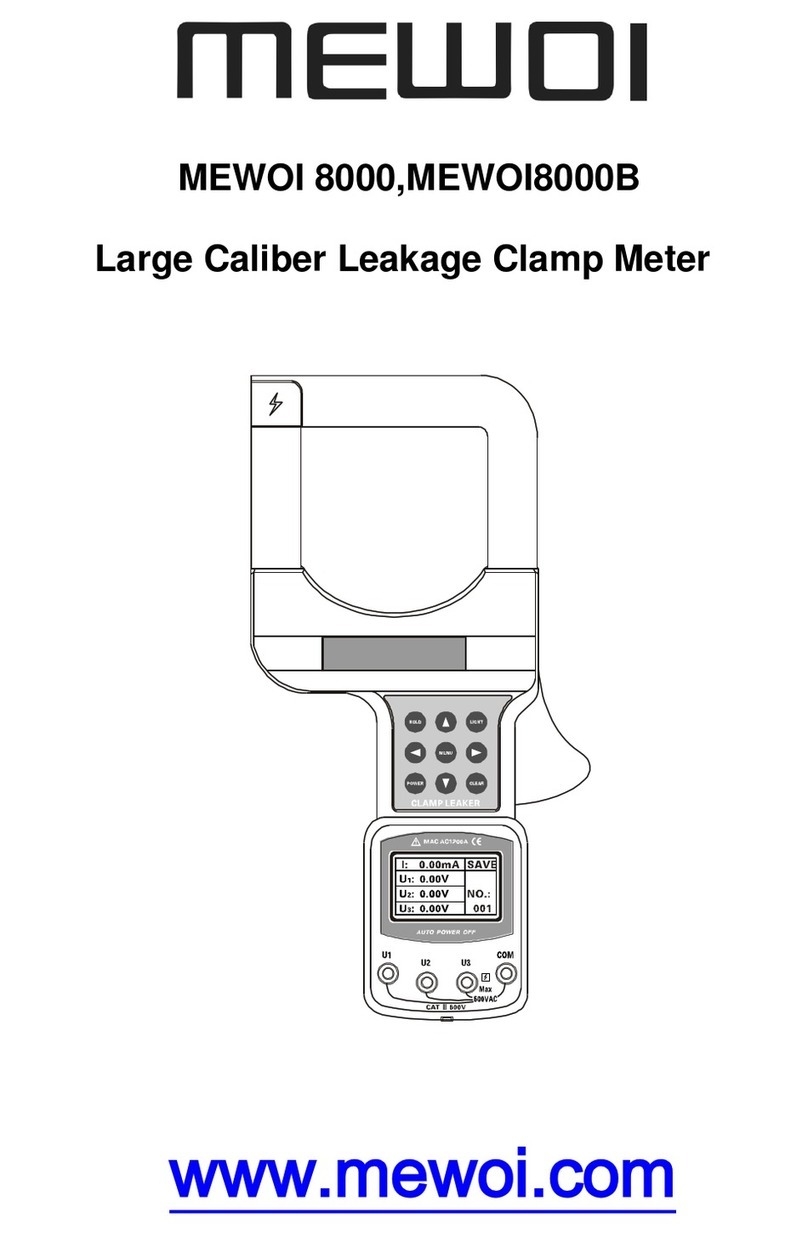
MEWOI
MEWOI 8000 User manual
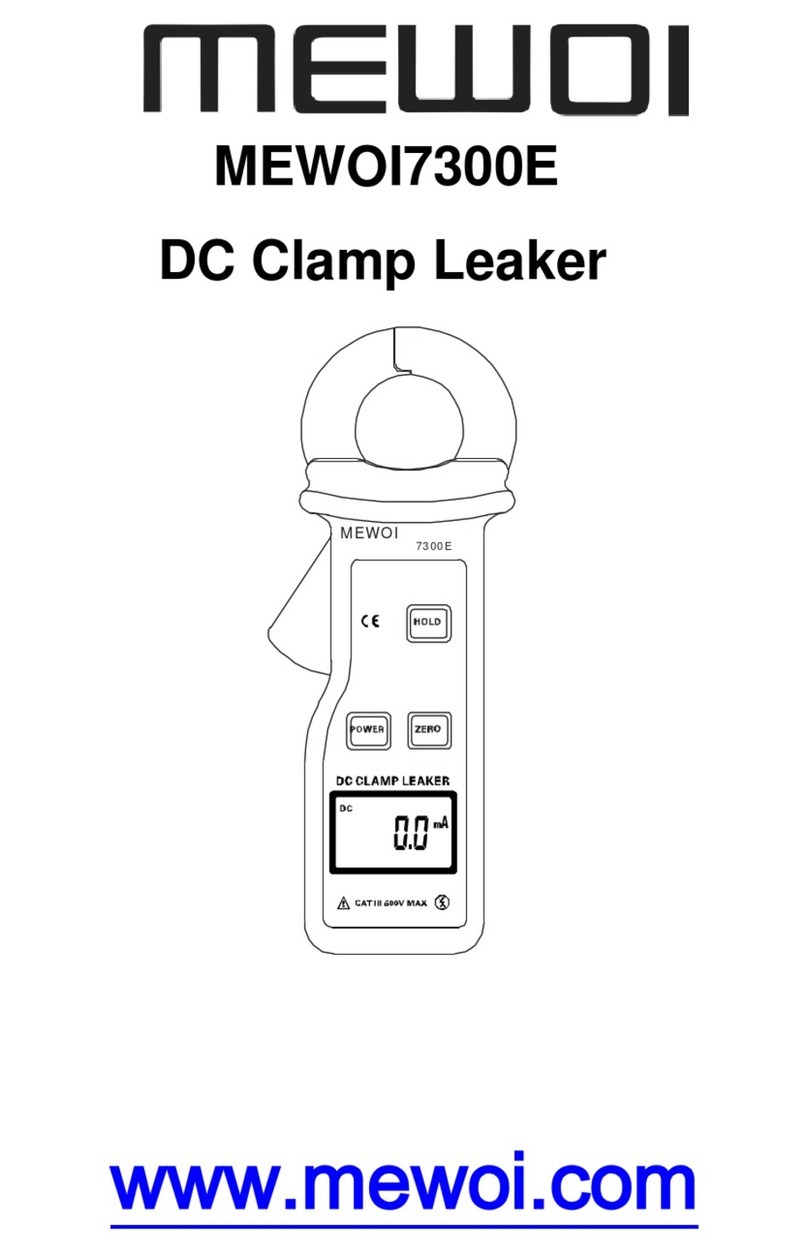
MEWOI
MEWOI MEWOI7300E User manual
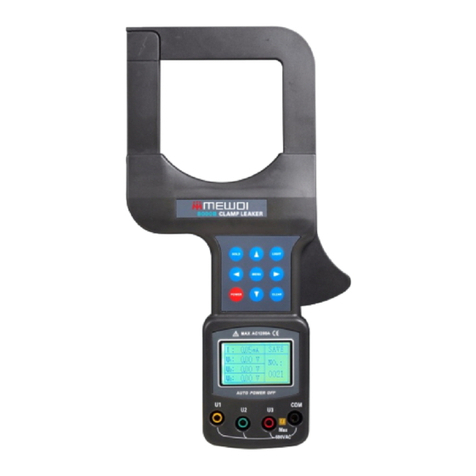
MEWOI
MEWOI MEWOI8000B User manual

MEWOI
MEWOI MEWOI400 User manual
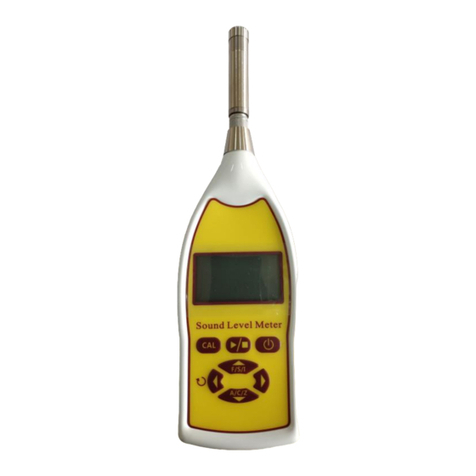
MEWOI
MEWOI MEWOI-JY218 User manual
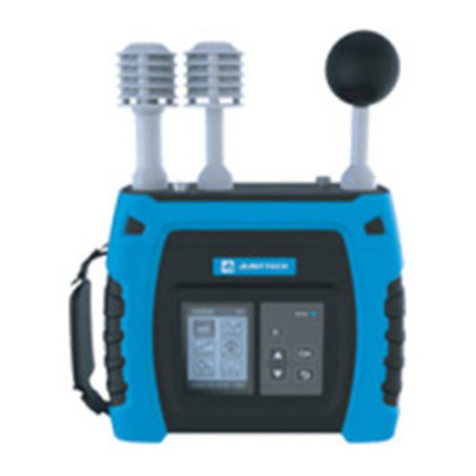
MEWOI
MEWOI WBGT2019A User manual
